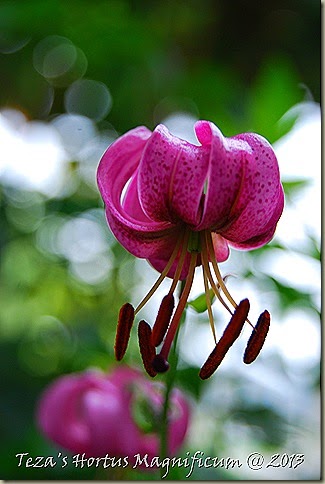What? You’ve never been felled by a hortgasm before? No weak knee, sweaty brow, heart palpitations for you? Trust me, they’re not deadly – well perhaps I should rephrase that – they can be lethally so on your sanity and pocketbook, but otherwise if you’re lucky enough [Jodi] to be able to cultivate these beauties, they are more than worth their weight in ultimate down and dirty pleasure!
I’ve spent the past three years trying to track down decent sized plants to bring into the garden centre. Last year I had half a dozen of my personal favourite Meconopsis x Sheldonii [ M. grandis x M. baileyi [syn. M. betonicifolia] shipped from the West Coast – too small to sell,. they are all nestled in a shaded nook of the garden – Spring holds the answer! I was able to locate both Meconopsis betonicifolia and Meconopsis grandis – both good sized plants that will arrive on the benches this Spring. Below is a brief desicription of both as well as a taxonomical warning to take into consideration when considering a purchase.

Identification and naming problems
Meconopsis grandis, M. baileyi (M. betonicifolia of hort.) and M. simplicifolia were introduced into cultivation from the early years of the 20th century. By the end of the century it was clear that there were problems in identification and nomenclature concerning the "big perennial blue Himalayan poppies". Clearly the species M. grandis, M. baileyi and M. simplicifolia, and probably others as well, had crossed haphazardly when grown in close proximity in gardens, thereby creating a range of sterile hybrids over the previous 80 years or so. Whilst some of the hybrids had been named, others had not. Also detailed descriptions and illustrations of named hybrids had been rather haphazard such that true identities were often in doubt. Not in doubt was the fact that individual sterile plants could often be traced back for 40 – 50 years and this in itself is quite remarkable. Of more recent appearance in cultivation were fertile hybrids. These are now raised annually in large numbers from seed.(e.g. M. ‘Lingholm’.)
Meconopsis betonicifolia commonly referred to as the Blue Himalayan Poppy is one of the most impressive plants for the shade garden. Plants form a rosette of hairy leaves, bearing large satiny flowers in an amazing shade of true blue. These are not always easy to please, demanding an evenly moist, rich soil and cool woodland conditions. Plants are not long lived, typically flowering in the second or third year, setting seed, then dying out. Gardeners in hot summer climates seldom succeed with these plants, yet they are surprisingly tolerant of cold winter conditions. Neutral to acidic soil, heavy in composted material is essential as all members of the genus are heavy feeders! Plants can be between 80-120cm in height with a spread of 30-45cm. Most all of the blue flowering species are monocarpic and are therefore very slow to multiply – relying of setting seed. I have had some first time growers tell me that in order to ensure adequate root development, they have removed the flower heads during its first year in the garden.
Meconopsis grandis is rare in cultivation, although plants or seeds given this name are frequently encountered in articles, plant catalogues, seed lists, in nurseries and garden centres and gardens open to the public. The majority of the plants and seeds still so frequently mislabeled M. grandis are usually the fertile hybrid M. 'Lingholm' (Fertile Blue Group). Another confusion is with the erroneously named M. grandis . Sometimes M. baileyi is also mis-identified as M. grandis. Fortunately efforts are being made to make the true species M. grandis more available. The distinguishing factor between the two is the larger sized flowers of a more startling true blue belonging to this species.
Specs:
80-120cm by 30-45cm. Plant in a well draining location in a soil that is heavy with composted materials as this genus is a true glutton when it comes to feeding! Plants respond best in a partial shaded location with morning and late afternoon sunlight. Touted to be monocarpic, they are typically not long-lived within the garden, so appreciate them while you can.
Coming to LittleTree in Spring 2011


































2 comments:
What an excellent post on Meconopsis.
Your last few posts have made it impossible not to visit Little Tree next spring.
Beautiful flowers. Hopefully yours will bloom for you this year. My fingers are crossed.
Post a Comment